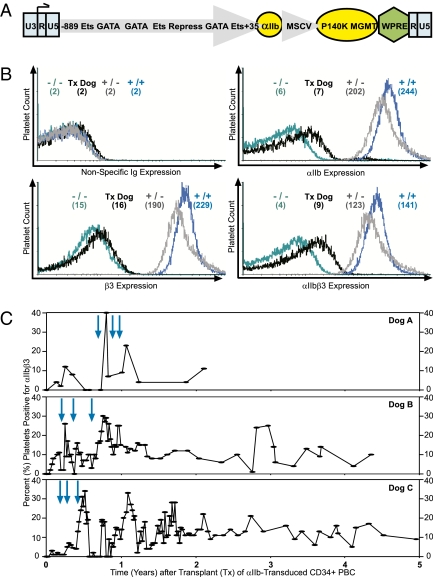Fig. 1.
Lentivirus transduction of GT CD34+ PBC generates integrin αIIbβ3 expression on platelets. (A) Diagram of HIV type 1 lentivirus vector, αIIb-(M)WPT. The 5′ LTR is intact (Left, blue box), whereas the U3 enhancer/promoter of the viral 3′ LTR (Right, blue box) was removed to allow the integrin αIIb gene promoter (large gray arrow) to direct megakaryocyte-specific synthesis of integrin αIIb (small yellow circle) in GT dogs with αIIb deficiency. The αIIb gene promoter binds GATA and Ets transcription factors for high-level gene expression in megakaryocytes, and there is also a repressor region that inhibits gene expression in other lineages. The murine stem cell virus promoter (small gray arrow) was used to drive lineage-nonspecific expression of a drug-selectable, biologically stable form of a DNA repair protein, MGMT (yellow oval) to allow in vivo enrichment of lentivirus-transduced hematopoietic stem cells. WPRE enhanced the efficiency of transgene expression (green diamond). (B) Immunofluorescent flow cytometric histograms of platelets isolated from circulating whole blood of transplant recipients. A representative histogram from dog C at 0.5 y after transplant (Tx, black line) revealed that the MFI (in parentheses) for platelets stained with a fluorochrome-conjugated nonspecific Ig (Upper Left) remained negative and equal to αIIb (−/−, turquoise; +/−, gray; +/+, navy) control animals. Remarkably, the MFI for platelets stained with an Ab specific for integrin αIIb (Upper Right), β3 (Lower Left), and the αIIbβ3 complex (Lower Right) revealed that transplant dog C expressed αIIb, β3, and αIIbβ3 to the surface at intermediate MFI levels compared with the MFI of platelets from αIIb(−/−,+/−,+/+) controls. The MFI of the transplant dogs was ≈6% of normal levels, with the complex specific antibody indicating that ≈5,000 αIIbβ3 receptors were present on the platelet surface. (C) The efficiency of transduction and duration of αIIbβ3 expression was determined by immunofluorescent flow cytometric analysis measuring the percentage of platelets with an MFI over background levels observed in an αIIb(−/−) dog in the presence of saturating Ab specific for αIIb, β3, and αIIbβ3 (used in B) shortly before transplant of dogs A, B, and C until 2, 4, and 5 y after transplant, respectively. GT dogs A, B, and C received an autologous transplant of CD34+ PBC carrying a lentivirus encoding integrin αIIb and a drug-resistant protein (P140K MGMT) and then were treated three times with cytotoxic drugs including O6-BG (100 mg) and carmustine (0.25 mg/kg, 0.40 mg/kg, and 0.45 mg/kg, respectively) (blue arrows). The percentage of platelets that expressed αIIbβ3 stabilized to ≈10% of the total platelet population in dogs A, B, and C.

